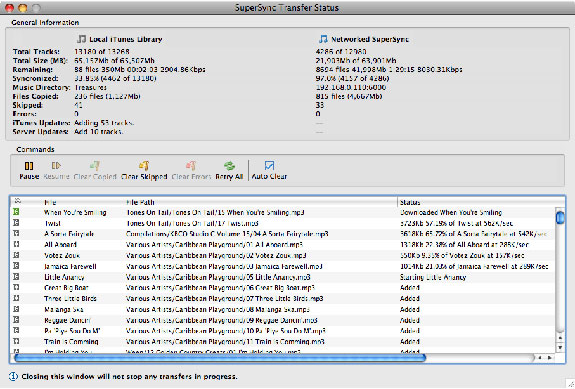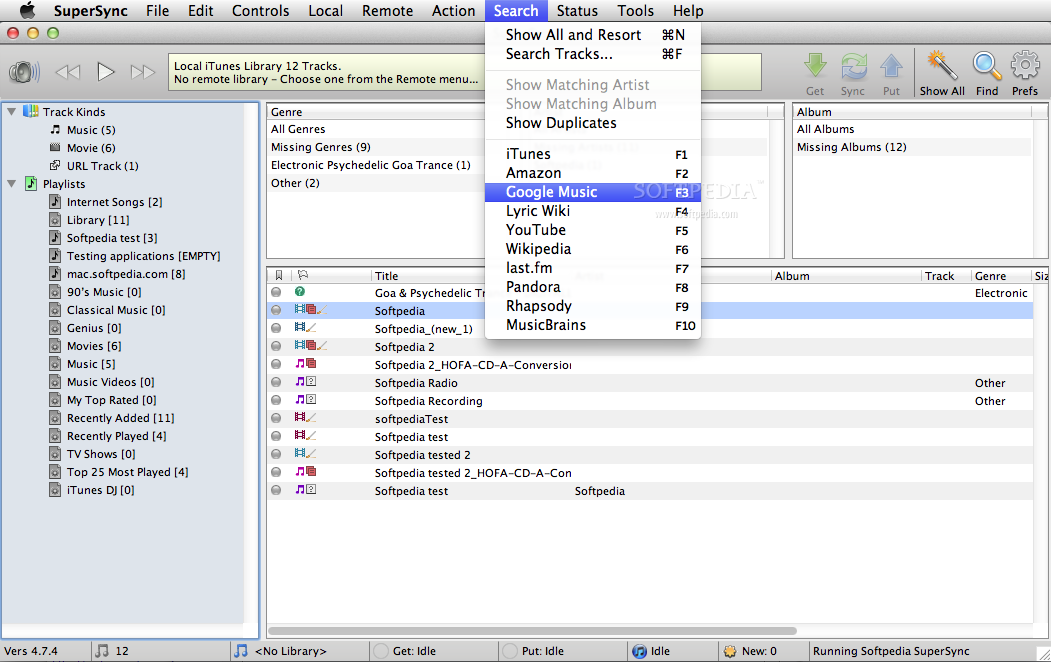
Note: The Remote Library can also be set to other types libraries such as an iPod, another hard drive, or another networked computer running SuperSync. For example, if you have a laptop and a desktop both running SuperSync, the desktop will be the Remote Library for the laptop. In most cases, the Remote Library will be the music library from another computer running SuperSync. The Remote library is the one you are comparing your Local Library. This is an advanced topic that is discussed in detail in the " Configuring the SuperSync Local Library" section in this manual. Note: The Local Library can also be set to other types libraries. For example, if you run SuperSync on your laptop, SuperSync will connect to that laptop's iTunes Library. By default, the Local Library is set to read the iTunes Library on that machine. The Local Library is a music library on the machine that SuperSync is running on. Once SuperSync reads your library/libraries, you can use the SuperSync's Get, Put, and Sync actions to move music between your two libraries. In SuperSync, we refer to these libraries as the Local and Remote Libraries. SuperSync can read a single library or two libraries at the same time. If you have music and video libraries at home, the office, on laptops, on iPods, iPhones, and disk drives, SuperSync can help you move and sync your iTunes content from one library to another, easily and intuitively.
Supersync flash for mac#
SuperSync is software for Mac and Windows that lets you compare and merge all of your music libraries on multiple computers and devices. Since the announcement of the Yongnuo YN-622C E-TTL radio triggers, lots of people have been asking questions.SuperSync Documentation SuperSync Documentation SuperSync Basics These will be complex devices and it is easy to get confused about their capabilities.
Supersync flash manual#
We’ve got a direct line to the developers, a copy of the instruction manual and will be getting hands-on soon. In the meantime, here is a Q&A to help you out. How does wireless E-TTL ratio control work?.Īnything we miss or don’t make clear, let us know in the comments.Is it possible to mix wireless manual flash and E-TTL in the same set-up?.When will the YN-622C be available and how much will it cost?.Will Lighting Rumours be doing a hands-on review?.Yongnuo, the manufacturer, describe the YN-622C system as “high performance master and slave equipment for multiple flash photography”. It is based on a two-way transmitter-receiver that allows one camera to control multiple flashes at the same time.


It runs on 2.4GHz radio with 7 channels and 3 groups (A, B, C).Įxternal flash functions include TTL ratio control, manual selection of flash group power output and high speed sync up to 1/8000s. TTL, Manual and Multi modes are supported.
Supersync flash install#
You can also install an E-TTL flash on top of the transmitter, known as “ TTL pass-through“. The Yongnuo YN-622C is more advanced than the Hähnel Tuff TTL, which does not give you control of manual power levels.The YN-622C is more capable than the Pixel King, which does not have TTL ratio control or let you have multiple groups at different power levels. However, there are models of the King for Nikon and for Sony. The YN-622C is less powerful than the Phottix Odin, since a smaller range of flashes and cameras are supported and the YN-622C doesn’t have its own LCD control panel.The YN-622C is more practical than the RadioPopper PX, which is a bulky hack that only extends the range of an existing infrared system.


 0 kommentar(er)
0 kommentar(er)
